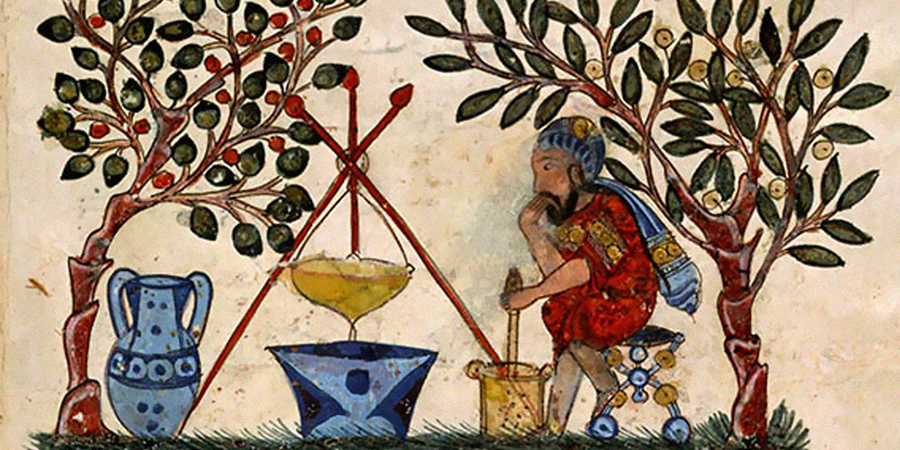“Nothing is more harmful to an old man than a good cook and a beautiful slave girl.”
— Thabit ibn Qurrah (d. 901 CE)
In our post-Covid world, we rightly celebrate the essential health workers, nurses, and physicians fighting to keep us safe. Once upon a time, though, before the EpiPen or the asthma inhaler, it was easier to remember the nearness of death, and, with it, the value of a good doctor. As part of the Islamic medical tradition that cleared away Europe’s intellectual haze beginning in the eleventh century, one finds biographical collections honoring medical experts. Known as tabaqat (“layers”), a term referring figuratively to people who share a profession—there are tabaqat works about theologians, mystics, poets, and grammarians—these collections spring from the same encyclopedic impulses that inspired Diogenes Laertius’s Lives of the Eminent Philosophers or Giorgio Vasari’s Lives of the Most Excellent Painters, Sculptors, and Architects.
The greatest Arab-Islamic medical tabaqat work is The Best Accounts of the Classes of Physicians, by the thirteenth-century Syrian ophthalmologist Ibn Abi Usaybi`ah. Edited with varying quality since the eighteenth century, the Classes has now gotten its second wind in the West. A team of eight scholars, led by Oxford professor Emilie Savage-Smith, labored for six years to prepare a new five-volume text and translation, funded by the London-based Wellcome Trust, and out this spring from Brill. Prohibitively costly to all but a few libraries, the Classes is available open access here, owing in no small part—and with no small amount of irony—to the pressures of a global health crisis.
Rather than a practical guide, the work gives a “world history of medicine,” sending up sayings, poetry, and lore—much of it as spurious as it is delightsome—on more than 400 doctors, sorted by period and location. Just as we now applaud our health workers, so too did Ibn Abi Usaybi`ah want to celebrate medicine, and it was for this reason that he wrote the Classes. It must be said, however, that celebration does not equal canonization; part of the book’s charm is it doesn’t shy from the foibles of its subjects. Above all, the experience of reading it can be summed up in Apuleius’ counsel in The Golden Ass: “Reader, pay attention, for you are going to enjoy yourself!”
*
Centuries before “medical humanities” projects like Reorienting Histories of Medicine or the NYU LitMed database, The Classes of Physicians paid tribute to the human side of healing. It was common in the author’s time for doctors to make their name as accomplished musicians, artists, and writers; hence a focus in the Classes on figures who practiced medicine only part of the time. Or, as the project editors say, the ideal physician is also a “paradigmatic courtier” who capers right along with cultural elites as he writes poetry, joins in courtly society, and tests his opponent’s wits. Little surprise that these elites—princes, rulers, colleagues, and teachers—were also Ibn Abi Usaybi`ah’s hoped-for audience.
The ideal doctor-as-Castiglionean courtier has much to do with Galen (d. 210 CE), the Greek surgeon whose towering image hangs over all the Classes. Out of reverence for Galen’s decree that the expert physician should be no less a philosopher, the book profiles thinkers—Socrates, Pythagoras, Ibn Rushd (“Averroes”), Ibn Bajja (“Avempace”), al-Kindi, al-Farabi—who in some cases wrote little to nothing about medicine. Where actual doctors are mentioned, the author prefers those with a measure of flair and panache.
Yet Galen’s reach also extends into medical practice itself. Early Syriac Christian doctors wrote commentaries on Galen that served for centuries as full-blown curricula. Galen’s theory of the four bodily “humors”—blood, yellow bile, black bile, and phlegm, the imbalance of which supposedly caused moods to change—was espoused from the earliest Arab physicians. In chapter seven, the semi-legendary figure al-Harith ibn Kaladah stands before the Sasanian Persian King Khosrow I and declares that four humors; not one, two, or even three; is the best number for “equilibrium and support.” In fact, the sweep of Galen’s penumbra over all of medicine, not just the Arab-Islamic tradition, cannot be overstated. For centuries, his methods offered the Byzantine Empire and the Latin Christian West a highly rationalized framework for diagnosis and treatment of diseases such as bubonic plague. In The Emperor of All Maladies, Siddhartha Mukherjee reminds us that a diagnosis of melancholia—an excess of “black bile,” or what psychiatrists now call depression—was current in Europe up to the eighteenth century.
*
Famously, Galen’s humor theory calls for techniques, like bleeding or cupping, aimed at restoring order back to the body’s fluids. But these methods are mostly absent from the Classes. Instead, in no less Galenic fashion, the treatments deal mainly with diet, then drugs, and finally surgery as a last resort.
Stories abound in which physicians help patients avoid illness or death using simple dietary adjustments. The Nestorian Christian doctor Bukhtishu` ibn Jibril, anxious to grant an irascible caliph his wish to eat mustard in hot weather (a recipe for ulcers or worse), mixes the spicy condiment with juice from a squash, thus offsetting heat with moisture. Another physician, Abu Hulayqah, wards off stomach issues for the Sultan al-Malik al-Kamil, known to Frankish Crusaders as Meledin, by fixing a cocktail of parsley, lemon, citron, and salt. Further tales warn against immoderate food intake, with Rabelaisian content that betrays them as fictions. The Persian polymath Abu Bakr al-Razi, known to Latin Europe as Rhazes, helps a man who has inadvertently swallowed a leech by forcing him to eat bucketfuls of moss until he vomits. A similar method is used by the Jacobite Christian doctor al-Yabrudi. In a scene reminiscent of many nights on the average university campus, he cures a man who had bet he could eat several pounds of boiled horse meat, chased by large helpings of beer.
At times, the physicians employ food in a quasi-supernatural fashion. It is said that Rhazes helped select the site of the famous `Adudi hospital at Baghdad by instructing servants to hang cuts of meat all over town, after which he noted the zone where the meat had putrefied least. Jibril ibn Bukhtishu`, father of the man who let the caliph have his mustard, warned another caliph, Harun al-Rashid of Arabian Nights fame, about what not to drink with his meal. Jibril divided the main course—fish—into three goblets; one filled with wine, a second with water, and a third with sundry meats. The fish became dissolved by the wine, bloated by the water, and rotted by the additional flesh, thus commending the wine as the ideal beverage.
*
Such augury reaches beyond the merely culinary. Doctors are shown forecasting the gender of unborn children with nothing but a vial of the mother’s urine, or, in one case, guessing the paramour of a lovesick patient by simply observing the latter’s symptoms (flushed cheeks, quickened pulse). Despite Ibn Abi Usaybi`ah’s scholarly sobriety and wariness of the fantastic, one cannot read the Classes of Physicians without catching premodern associations between medicine and the occult.
This is especially true of astronomy and astrology. Early thinkers in Europe as well as the Middle East took the human body as a microcosm of the universe, as readers will recall from the Canterbury Tales:
A Doctor too emerged as we proceeded;
No one alive could talk as well as he did
On points of medicine and of surgery,
For, being grounded in astronomy,
He watched his patient closely for the hours
When, by his horoscope, he knew the powers
Of favorable planets, then ascendant,
Worked on the images for his dependent.
The Classes therefore cites many Islamic authorities on astrology, including Abu Ma`shar al-Balkhi, Ibn al-Dayah, and Thabit ibn Qurrah. The great philosopher Ibn Sina (“Avicenna”) wrote a long poem on planetary conjunction which Ibn Abi Usaybi`ah incorporates in his entry; to account for a terrible plague that struck in the year 1054 CE, the Classes notes that a supernova had risen in Gemini. Not just astronomy but also folk beliefs informed good health practices, as in legends of suppliants arriving at the graves of Asclepius and Aristotle to seek wisdom and healing (Paulus Orosios, a fourth-century Spanish priest, writes about this phenomenon in his Seven Books of History Against the Pagans).
Yet for some sufferers, neither magic nor astrology but instead a clever ruse is just what the doctor ordered. The results are nothing short of vaudevillian. To cure a woman of her life-threatening hiccups, Bukhtishu` ibn Jibril orders servants to throw many pots off a building all at once to make a loud crash and startle her, thus relieving her condition. Bukhtishu`’s father, Jibril, receives a fortune in silver when he helps one of the caliph’s concubines regain movement in her arm. The doctor seizes the hem of her skirt, as if to lift it and expose her modesty, and to everyone’s relief she miraculously snatches away the garment, affirming the principle of “mind over matter” avant la lettre.
Speaking of lifted skirts, the topic of sexual health often gets a full chapter in premodern medical guides, or, in cases like the fifteenth-century Catalan text Speculum al foderi, an entire treatise all to itself. The Classes stops short of anything so colorful, but does let doctors show their earthy side. Avicenna’s renowned sex drive apparently took its toll on his health, and Hippocrates did not deny having a legendary libido after a group of students showed his portrait to Polemon, an expert in physiognomy—the art of assessing a person’s character from their physical appearance—who told them, “This is a man who loves to fornicate.”
*
Other times, sex is the favorite groundwork of insult. In a dispute between the physician Yuhanna ibn Masawayh and his colleague’s son Daniyal over a grouchy pet peacock, Yuhanna insults what he supposes to be Daniyal’s quaggy genitalia, while Daniyal retorts that he cannot love anyone (like Yuhanna) with a mistress named Qaratis, a Byzantine word apparently meaning a woman who cuckolds her husband. This same Yuhanna held a grudge against another man, the foul-mouthed doctor Sahl al-Kawsaj (“The Beardless”), who claimed to have seduced Yuhanna’s mother.
No mere aside, such enmities in fact stand at the center of the Classes. Ibn Abi Usaybi`ah jockeyed throughout his life to secure a livelihood from rulers and patrons; little wonder that he should fixate on rivalries and intrigues of the past. A chief case is that of the Christian medical translator Hunayn ibn Ishaq, who tells his own—probably apocryphal—tales of harassment. Above all, he relates how he was made to spit on a Madonna-and-child painting to prove his hatred of iconography to the Muslim caliph, who then informed on him to the head of the Nestorian Christian Church as proof of blasphemy.
Other conflicts unfold between doctors themselves, such as the quarrel that exploded in the tenth century between Ibn Butlan and Ibn Ridwan, two of Islamic medical history’s brightest stars. Their bitter correspondences, translated in Schacht and Meyerhoff’s Medico-Philosophical Controversy, sound like sparring matches between Norman Mailer, Gore Vidal, and John Le Carré in the bad old days of highbrow toxic masculinity. Here, for instance, is Ibn Butlan insulting Ibn Ridwan’s looks with a zesty epigram:
When his face showed itself to the midwives,
they turned on their heels in regret,
saying (but lowering their voices for decency’s sake)
“Ah, if only we had left him in the womb!”
With tantalizing irony, Ibn Abi Usaybi`ah himself avoids all mention of a gigantic figure in medicine, Ibn al-Nafis, who shared the same mentor as the author of the Classes and who was probably his rival.
Yet, despite these feuds, one sees tender affection between doctors and patients. Short poems are preserved in the Classes sent by grateful clients. Harun al-Rashid, having been spared a stomach ache by the three-goblet augury of Jibril ibn Bukhtishu`, supposedly said, “How can I be angry with him when he takes such good care of me?” These glimpses remind us that lifting a glass to health workers has never gone out of style. We would do well to remember this when sprawling bureaucracies like the Center for Disease Control or the World Health Organization prove less dependable than we once thought. As humankind now confronts the greatest health crisis in living memory, it will no doubt be the individual healers, daunted yet full of compassion, who lead the long climb back.





